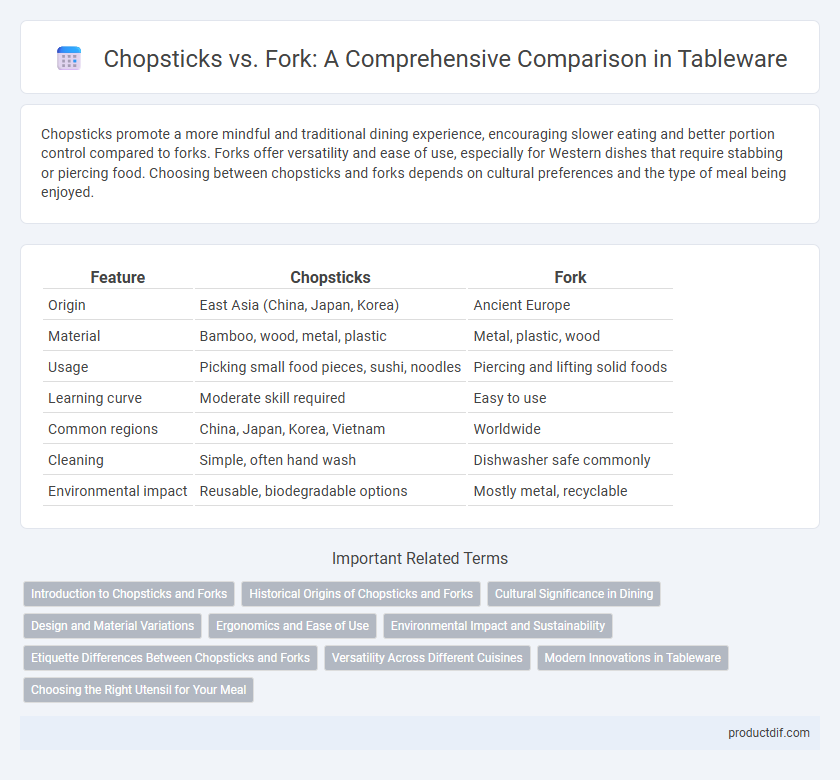Chopsticks promote a more mindful and traditional dining experience, encouraging slower eating and better portion control compared to forks. Forks offer versatility and ease of use, especially for Western dishes that require stabbing or piercing food. Choosing between chopsticks and forks depends on cultural preferences and the type of meal being enjoyed.
Table of Comparison
| Feature | Chopsticks | Fork |
|---|---|---|
| Origin | East Asia (China, Japan, Korea) | Ancient Europe |
| Material | Bamboo, wood, metal, plastic | Metal, plastic, wood |
| Usage | Picking small food pieces, sushi, noodles | Piercing and lifting solid foods |
| Learning curve | Moderate skill required | Easy to use |
| Common regions | China, Japan, Korea, Vietnam | Worldwide |
| Cleaning | Simple, often hand wash | Dishwasher safe commonly |
| Environmental impact | Reusable, biodegradable options | Mostly metal, recyclable |
Introduction to Chopsticks and Forks
Chopsticks, traditionally made from wood, bamboo, or metal, are essential utensils in East Asian cultures, enabling precise handling of small food pieces and enhancing the dining experience with rice and noodle dishes. Forks, commonly made from stainless steel, serve as versatile western cutlery designed for piercing and lifting solid foods, offering ease of use with diverse cuisines. Understanding the cultural origins and functional design of both chopsticks and forks highlights their roles in global dining practices and culinary etiquette.
Historical Origins of Chopsticks and Forks
Chopsticks originated over 5,000 years ago in ancient China, initially used for cooking and evolving into eating utensils during the Zhou Dynasty. Forks appeared much later, with the earliest known use dating back to the Byzantine Empire around the 4th century, and became widespread in Europe by the 16th century. The distinct historical origins reflect cultural differences, with chopsticks emphasizing communal dining and precise handling of food, while forks symbolize individual dining and utensil refinement.
Cultural Significance in Dining
Chopsticks hold deep cultural significance in East Asian dining, symbolizing respect, tradition, and communal sharing during meals, often associated with rituals and etiquette unique to countries like China, Japan, and Korea. Forks, predominant in Western cultures, reflect individual dining preferences and are linked to the evolution of European culinary practices emphasizing convenience and diversity in food consumption. Understanding the cultural context of chopsticks and forks enhances appreciation of global dining customs and promotes cross-cultural respect.
Design and Material Variations
Chopsticks are typically crafted from bamboo, wood, or stainless steel, featuring slender, lightweight designs that enhance precision and cultural authenticity. Forks vary widely in materials from stainless steel to plastic and titanium, with tines designed for piercing and scooping food, offering ergonomic handles for comfort and versatility. Design variations in chopsticks emphasize simplicity and tradition, whereas forks showcase structural diversity to accommodate different cuisines and serving styles.
Ergonomics and Ease of Use
Chopsticks promote fine motor skills and require precise finger coordination, enhancing dexterity but posing challenges for beginners. Forks offer a more intuitive grip with ergonomic handles designed for comfort and ease, making them accessible for people of all ages and abilities. The choice between chopsticks and forks often depends on cultural familiarity and the type of cuisine being consumed.
Environmental Impact and Sustainability
Chopsticks, often made from sustainably harvested bamboo or wood, have a lower environmental footprint compared to metal forks, which require extensive mining and energy-intensive manufacturing processes. Disposable wooden chopsticks pose deforestation risks unless sourced from certified plantations, while reusable forks, typically stainless steel, demand significant resources for production but offer longevity with reduced waste. Choosing reusable chopsticks or environmentally certified wooden options and high-quality, durable forks supports sustainable tableware consumption and minimizes environmental impact.
Etiquette Differences Between Chopsticks and Forks
Chopsticks require precise handling and etiquette, such as not sticking them upright in rice or passing food directly from one set of chopsticks to another, which are considered disrespectful gestures in many Asian cultures. Fork etiquette emphasizes keeping the utensil in the dominant hand, using it to spear or scoop food neatly, and avoiding gestures like waving or pointing with the fork. Understanding these etiquette differences enhances cultural appreciation and ensures respectful dining practices across diverse table settings.
Versatility Across Different Cuisines
Chopsticks offer exceptional versatility across Asian cuisines such as Chinese, Japanese, and Korean, facilitating the handling of delicate sushi, noodles, and small bite-sized pieces. Forks, predominant in Western dining, adapt well to a wide variety of dishes ranging from salads to grilled meats, providing sturdy support for piercing and scooping. Each utensil enhances the dining experience within its culinary tradition, highlighting cultural preferences and ergonomics tailored to specific food textures and presentation styles.
Modern Innovations in Tableware
Modern innovations in tableware have transformed traditional utensils like chopsticks and forks with ergonomic designs and sustainable materials such as bamboo composites and biodegradable plastics. Smart chopsticks now integrate sensors to monitor eating habits and promote mindful dining, while forks feature antimicrobial coatings and foldable designs for portability. These advancements enhance functionality, hygiene, and user experience, reflecting evolving consumer preferences in contemporary dining culture.
Choosing the Right Utensil for Your Meal
Choosing the right utensil for your meal depends on the cuisine and dining experience you seek; chopsticks offer precision and control for Asian dishes like sushi and noodles, while forks provide versatility and ease for Western meals such as salads and steaks. Material and design also affect functionality; bamboo or stainless steel chopsticks enhance grip and authenticity, whereas stainless steel or plastic forks ensure durability and comfort. Understanding meal type and utensil ergonomics ensures an enjoyable and culturally appropriate dining experience.
Chopsticks vs Fork Infographic

 productdif.com
productdif.com